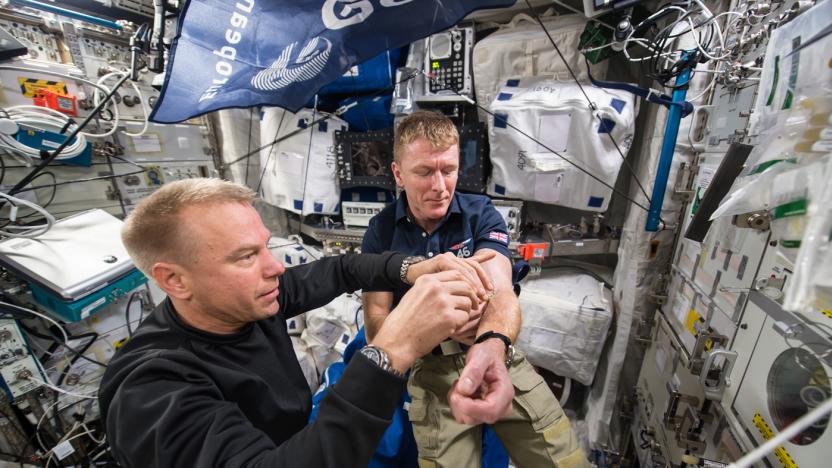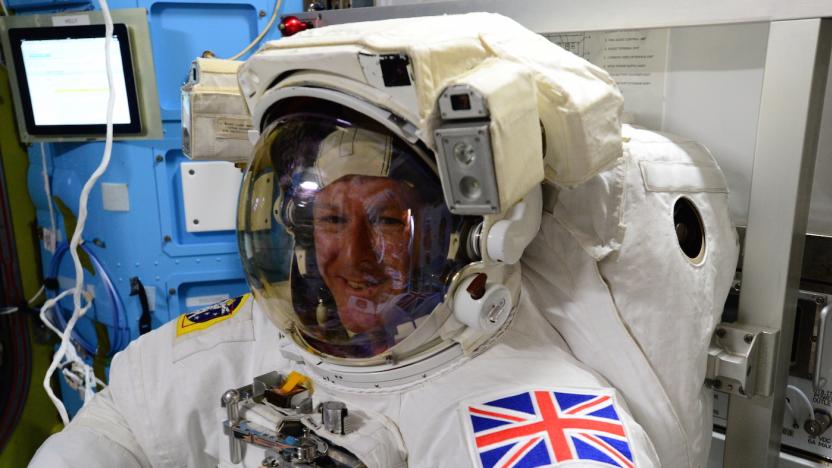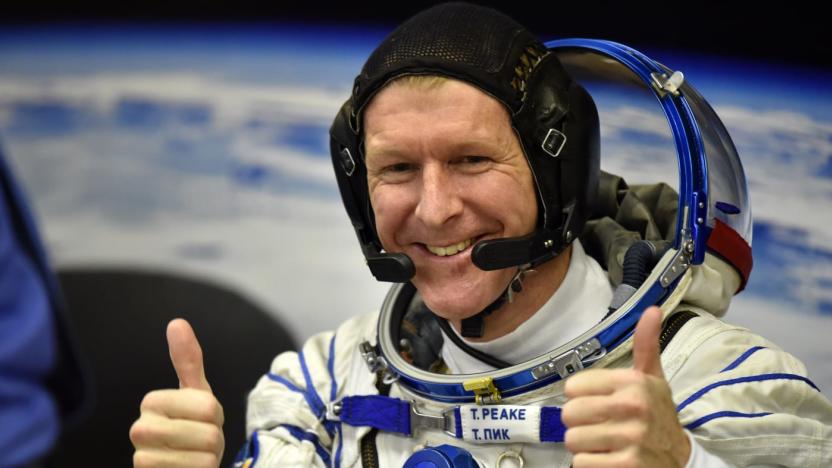internationalspacestation
Latest

Astronauts are trying Microsoft HoloLens in space
Astronauts will soon have plenty of sweet tools at their disposal, but nothing quite like this -- as promised, NASA recently began testing Microsoft HoloLens aboard the International Space Station. The augmented reality headset is there as part of an experimental project, Sidekick, that gives crews a helping hand without having to flip through thick manuals or stay on the radio. Someone on the ground can use Skype to not only offer voice directions during repairs, but draw notes at the moment they're relevant. They'll also get animated visuals on top of real-world objects, showing them how to complete less-than-obvious tasks.

Experiment to determine why astronauts feel weak back on Earth
Astronauts don't have it easy when they come home, and it's not just because of the change in gravity: their red blood cell production drops while they're in space, leaving them weakened on Earth. But why? That's what a Canadian experiment aboard the International Space Station hopes to find out. The research is testing red and white blood cell functions, as well as bone marrow fat levels, to see how they change before, during and after spaceflight. It should not only show how microgravity (and the resulting lack of activity) affects blood cells, but how reversible the effects are. How soon could you go back to normal?

Astronaut Scott Kelly hosts a Reddit Q&A from space at 4PM ET
You may have seen some interesting Reddit Q&A sessions in your day, but you probably haven't seen one like this. NASA astronaut Scott Kelly is hosting an Ask Me Anything session at 4PM Eastern today (January 23rd)... from space. That's right -- you can learn what it's like to live aboard the International Space Station from someone who's there right now. Suffice it to say there are plenty of questions: how does long-term residency in space affect you, physically and psychologically? What's the coolest thing you've seen while orbiting Earth? And what's it like to grow flowers in space? There's no guarantee that Kelly can answer every burning question, but it'll be worth participating just to get his unique perspective. [Image credit: Scott Kelly, Twitter]

NASA wants your ideas for its cube robot's arm
Think you could build a better robot arm than NASA? You now have a chance to prove it. The agency is teaming up with Freelancer to crowdsource ideas for the arm on Astrobee, a cute cube robot that will float around the International Space Station monitoring conditions and supplies. The first phase will have NASA pick the top 30 entries that meet some basic criteria. If you pass muster, you'll be asked to break down the architecture options for your design. Do that and NASA will run another crowdsourcing effort to solicit ideas for the subcomponents from those 30 submissions. Phew.

Here's how you make coffee in the International Space Station
Now that the International Space Station is in bloom, how about a nice cup o' joe to enjoy alongside the (single piece of) greenery? European Space Agency astronaut Tim Peake pulls out a coffee with cream vacuum pack (with the delicious sounding sugar substitute), and inserts it into the most high-tech kettle we've ever seen. This injects hot water into the pack, and one plastic straw later you're drinking space coffee. Which is obviously the best kind of coffee. It seems astronauts are still waiting on that space-ready espresso machine from Lavazza.

Spacewalk cancelled after water found in helmets again
Mission control had to cut short an ISS spacewalk on Friday after US astronaut Tim Kopra noticed water building up in his helmet hours into the excursion. Both Kopra and British astronaut Tim Peake are back and safe inside the International Space Station.

Watch Tim Peake become the first Briton to spacewalk
At 12:55pm GMT (7:55am ET, or 4:55am PT) British astronaut Tim Peake will step outside the International Space Station (ISS) for the first time. He'll be accompanied by NASA astronaut Tim Kopra and together they'll perform some crucial repair work. The pair's main task is to replace a broken Sequential Shunt Unit (SSU) which transfers power generated by the Station's solar arrays. As the European Space Agency explains, the job needs to be completed within 30 minutes while the ISS passes through the Earth's shadow, as this mitigates the risk of high-voltage sparks.

NASA picks three private space companies to resupply the ISS
NASA will fund the International Space Station at least through 2024, so keeping the astronauts on it fed and experimenting is a big deal. That's why the nation's top space agency announced new resupply contracts for Orbital ATK and Elon Musk's SpaceX, two major incumbents that were joined by newcomer Sierra Nevada and its resumable, mini-spaceplane. Each company will get at least six resupply missions, but it's "likely" that NASA will buy more than 18 flights — NASA will grant additional missions based on what they and the station's spacefaring crew need at the time.

British astronaut Tim Peake will spacewalk next week
It's the moment every astronaut dreams of. Tim Peake has been told he'll be exiting the International Space Station (ISS) next week and conducting a spacewalk with NASA astronaut Tim Kopra. The pair have been tasked with replacing a broken Sequential Shunt Unit that transfers power generated by the space station's solar arrays. There are eight of these in total, so the problem isn't too serious, and the European Space Agency (ESA) says it can be removed by undoing a single bolt. Simple!

Watch the first British astronaut in over 20 years blast off for the ISS
One in, one out. Or to be more specific, three in and three out. A trio of astronauts descended from the International Space Station (ISS) on Friday, making way for a new group of space-smitten explorers. Among the group blasting off today is Tim Peake, the first British astronaut to visit the ISS and the first UK astronaut to explore space in over 20 years. He'll be joined by NASA astronaut Tim Kopra and experienced cosmonaut Yuri Malenchenko, who in 2003 became the first person to marry in space.

Orbital Sciences launches first spacecraft since 2014 explosion
After some weather delays, Orbital Sciences has reclaimed some of its lost reputation. The private spacecraft firm has successfully launched Cygnus, its International Space Station resupply mission, aboard an Atlas V rocket. It's a relatively routine unmanned flight carrying over 7,300 pounds' worth of cargo, but it represents an important return to form for the company after its Antares craft exploded on launch last year. Let's just hope this is an auspicious sign for space travel as a whole -- it's had far too many tragedies in recent months.

A British astronaut will run the London Marathon in space
Running the London Marathon is hard enough. Running it in space? That's another challenge entirely. British astronaut Tim Peake is headed to the International Space Station (ISS) on December 15th and wants to complete the race at the same time as everyone down on Earth. He won't be running the actual route though -- instead, he'll be on a treadmill with a harness system that includes a waist-belt and shoulder straps. These will apply some much-needed downforce to counter Peake's weightlessness and recreate his natural running style in space. He'll also have a video feed of the route which will speed up and slow down to reflect his pace.

NASA to test sugary bacteria as space-based power source
Following its successful harvest of red leaf lettuce, NASA has announced plans to launch genetically engineered bacteria into orbit to see if they can be harnessed by future astronauts as potent survival resource. The experiment is scheduled to take place in 2017 and will study the genus Anabaena. The sugars that these cyanobacterium photosynthesize can be fed to other genetically-modified bacteria in a system the agency calls PowerCell. These second-stage bacteria would, in turn, generate chemicals, food, fuel and even medicine for far-flung astronauts. "The first pilgrims who came to the Americas didn't bring all their food for the rest of their lives," Lynn Rothschild of NASA's Ames Research Center, said in a statement. "You need to live off the land."

NASA orders SpaceX to taxi astronauts to the ISS in 2017
Right now, flying to the International Space Station means leaving from Russia, but it won't always be that way. Today, NASA announced that it officially ordered a crew rotation mission from Elon Musk's SpaceX, due to launch sometime in 2017. This is actually the second mission order to come out of the space agency's Commercial Crew Program -- the first order being awarded to Boeing back in May -- but it's still not clear which commercial outfit will have the honor of playing taxi for astronauts first.

NASA's growing flowers on the ISS for the first time
Following upon its initial successes with lettuce back in August, NASA astronauts aboard the International Space Station are attempting to coerce a colony of zinnias to flower for the first time. The effort is part of the larger Veggie plant growth system which is studying the effects of microgravity on plant life.

NASA wants to hire more astronauts
Have you dreamed of becoming a space explorer? You now have your chance to do something about it: after a four-year silence, NASA is once again hiring new astronauts. The recruiting drive will run between December 14th and mid-February, with the final selections made public in mid-2017. You'll need the right mix education, experience and stamina to even get your foot in the door (there's a long-term spaceflight physical, for example). However, it could easily be worth clearing that high bar.

Astronauts capture stunning 4K video of antacid bubbles aboard the ISS
NASA released 4K video of astronauts aboard the International Space Station experimenting with water, antacid and food coloring to create incredible, fizzing aqueous spheres in the zero-G environment. The ISS crew captured the footage with a Red Epic Dragon camera, which NASA is evaluating for use in monitoring scientific experiments, celestial phenomena and and vehicle operations. According to the space agency, this is among the first such footage of its kind. We can only hope it won't be the last.

ICYMI: The Martian colony plan, simulated rat brain and more
#fivemin-widget-blogsmith-image-424179{display:none;} .cke_show_borders #fivemin-widget-blogsmith-image-424179, #postcontentcontainer #fivemin-widget-blogsmith-image-424179{width:570px;display:block;} try{document.getElementById("fivemin-widget-blogsmith-image-424179").style.display="none";}catch(e){}Today on In Case You Missed It: We are rounding up Space Week with NASA's detailed plan to get earthlings to settle on Mars. Meanwhile other scientists teamed up to unravel how a rat's brain works, to then simulate it with a computer. Early testing shows how calcium affects the brain in a way that can only help with studies on neurological disorders. And Disney is jumping into more augmented reality with a coloring book app that brings creatures to life while they're worked on.

Space whisky really does taste different
When Scottish distiller Ardbeg launched whisky into space to see whether or not the drink ages differently in microgravity, it came across as little more than a publicity stunt... which, admittedly, it still is. However, the company has finally published its results, and it's clear that this liquor was changed by its stay in the International Space Station. Going into orbit altered the ratios of acids and other chemicals, which had a pronounced effect on the taste. While the Earth-based whisky is dry, with notes of "woody" flavors" and "sweet smoke," the space whisky recalls "smoked fruits" and carries an aftertaste that reminds Ardbeg of "antiseptic lozenges" and "rubbery smoke." You won't be breaking this out to celebrate a special occasion, then, unless you like recalling the smell of burning tires.

ISS astronaut will get to drive and 'feel' a rover on Earth
It's going to be a little while before humanity sets foot on Mars, but in the meantime NASA has a bundle of robots exploring the planet for us. The data they're collecting is valuable, but now researchers want to give their operators greater control. Specifically, they're interested in force feedback -- timely vibrations that would help astronauts carry out difficult tasks remotely. The European Space Agency (ESA) has developed a new rover with this in mind -- the "Interact Centaur," which has an onboard camera and two force-sensitive arms. ESA astronaut Andreas Mogensen is headed to the International Space Station (ISS) on September 2nd and, five days later, he'll be controlling one that's back on Earth.






